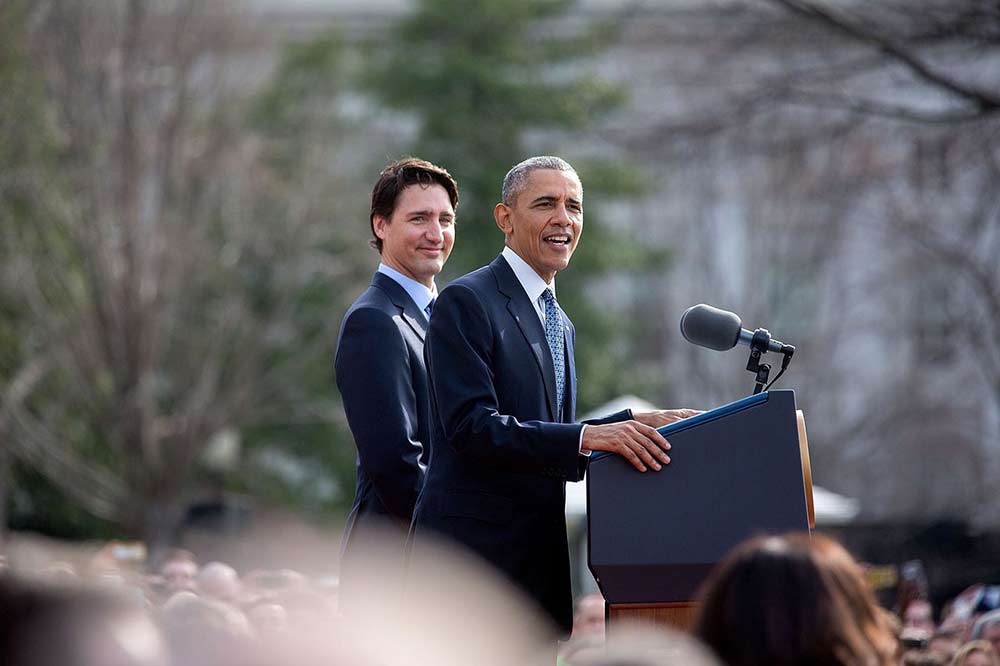
When U.S. President Barack Obama welcomed Canadian Prime Minister Justin Trudeau to Washington with a much-publicized state dinner, the two expressed a warm, collaborative relationship.
After trading friendly jabs about hockey and the weather, the two got down to business and discussed, among several issues, how to streamline trade and border crossings between the two nations.
For many, this signalled a warming trend in trade relations between the Canada and the U.S., which had been cooling over contentious issues such as the rejected Keystone XL Pipeline project.
Canada is no longer the top market for American trade
As allies and neighbours along the world’s longest shared border, Canada and the United States have become inextricably linked over the course of a relationship that spans more than two centuries. Politically, culturally and economically, the two countries remain tied to one another.
For decades, Canada and the U.S. have enjoyed the largest trade relationship in the world. Two-way trade more than tripled in the years since the Canada-U.S. Free Trade Agreement was implemented in 1989.
NAFTA superseded the agreement in 1994, taking trade between the two nations to greater heights, amounting to an impressive $2.4 billion per day in 2014, and supporting almost 9 million U.S. jobs.
Unfortunately for Canada, trade with the U.S. seems to be on the decline. Trade between the two countries totaled an estimated $662.7 billion in 2015, down from US$760 billion in goods and services in 2014.
In November 2015, China surpassed Canada for the first time as the biggest trading partner to the U.S., bumping Canada down to second place.
And China isn’t the only country vying for first place and expanding trade with America. Mexico is steadily gaining ground in trade with their NAFTA neighbour, trading more with the U.S. than Canada did in September 2015.
Impact of blundering energy sector being felt
A major contributor to the recent drop in trade with the U.S. is the floundering energy sector. The U.S. is by far the biggest customer for Canada’s exports in natural gas, oil and hydropower.
In 2010, almost 100% of Canada’s energy exports went to the country’s southern neighbour, a huge chunk of total Canadian exports into the U.S.
This dynamic is in a transitional period due to America’s expansion in their own tight oil and shale gas production, and a forecasted decrease in oil and natural gas consumption in the coming years.
The decision to block the proposed Keystone XL pipeline may also prove to have negative effects on the two nations’ trade in oil going forward.
Still no resolution in the most contentious trade dispute
Another sticking point in Canada’s trade relationship with the U.S. has been the ongoing softwood lumber dispute. The dispute is one of the lengthiest disagreements the two countries have faced in modern history.
About 80% of the global lumber industry is made up of trade in wood from conifers, or softwood. Disagreements over the softwood lumber trade between the two states began in the 1980s and have not since been satisfactorily resolved.
In the latest agreement, implemented in 2006, the U.S. agreed to drop anti-dumping tariffs as long as lumber prices remained at an acceptable level. This agreement was set to expire in 2012, but was then extended for another two years.
Neither country is happy with the outcome, and ongoing issues remain as the deal faces renewal.
Many Canadian industry representatives are calling for another extension of the 2006 deal, while those representing the industry in the U.S. are calling for major changes.
Negotiations between the two countries on this deal are likely to be slow and arduous due to the history of contention on the issue.
After meeting in Washington in early March, Prime Minister Trudeau and President Obama committed to explore all options in order to solve the trade dispute.
Chrystia Freeland, Canada’s International Trade Minister, said:
What we have committed to is to make significant, meaningful progress towards a deal — to have the structure, the key elements there 100 days from now.
U.S. softwood lumber production is on the rise, with more Canadian-owned sawmills located in the U.S. than in Canada due to lower labour costs, higher timber availability, and higher demand.
Low loonie is luring some U.S. business to Canada
The Canadian dollar began a dramatic plunge in January 2016 that brought the currency to its lowest level since 2003, bottoming out at 70 Canadian cents to the U.S. dollar.
The drop in value, though detrimental to consumers purchasing imported products, has also been touted as an opportunity for Canadian businesses doing business with the U.S., from commodities exporters to the tourist industry.
Canadians can benefit from the attractively low loonie by leveraging increased trade and foreign investment from the U.S., and thereby increase their export revenue.
Canadians can also expect more U.S. visitors during the upcoming tourism season, as the country provides a destination that is much more affordable while the loonie is low.
Trans Pacific Partnership agreement may be a non-issue
It’s no secret that the Obama administration is keen to pass and implement the TPP. Canada has gone as far as to sign on to the deal, but has committed to consulting with Canadians and considering all economic impacts before ratifying.
At their most recent meeting in Washington in March, Trudeau and Obama released the following joint statement on the agreement:
“The United States and Canada share the goal of enhancing shared prosperity, creating jobs, protecting workers and the environment, and promoting sustainable economic development.”
Recognizing that the Trans-Pacific Partnership, which links together countries that represent nearly 40 percent of global GDP, would advance these objectives, Canada and the United States are working to complete their respective domestic processes.
However, the Canadian government has been careful in proceeding and committing 100% to the deal due to a significant anti-TPP sentiment in the country.
If the TPP is not ratified before the end of Obama’s term in November, it’s hard to know what the future of the agreement would be, and how trade relations between the two countries would proceed, given that the U.S. presidential candidates are unanimously rejecting the deal.
Fortunately, many have speculated that the trade relationship would not change drastically with or without the signing of the TPP, as previous agreements, notably NAFTA, would still be in effect either way.
What do you think the future has in store for the US-Canada trade relationship?








disqus comments